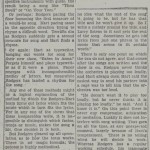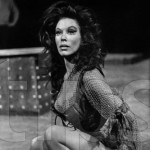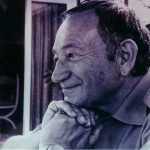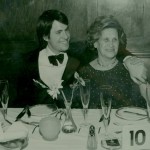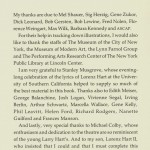by Michael Elihu Colby
Part 20: Getting to the Hart of Things
The last moments in the life of Lorenz (Larry) Hart were recounted in haunting detail by his sister-in-law, Dorothy Hart:
Then suddenly, at exactly nine o’clock on the evening of November 22 [1943], the lights went out. The war blackout [had] darkened the hospital corridor. And at that moment someone exited from Larry’s room and shook his head. We could barely see him.
“He’s gone.”
This is a moment I can’t forget, but also can’t quite remember; I was in a merciful state of shock that remained for a long time.1




Erudite, hilarious, and innovative, he was a trailblazer of his profession. He had been the epitome of enthusiasm in his youth, but gradually suffered a spiritual decline. Under 5 feet and self-effacing, he hit emotional bottom through alcoholism, one of several facts that struck intense chords in me. Meeting a range of his friends during my research, I sometimes felt like I knew Hart personally. But it became hard to separate truth from fantasized nostalgia. Many of these friends claimed that Hart called out for them on his deathbed. If everyone who made this claim were telling the truth, Hart would still be alive calling out for them.
Then there were private issues about Hart that were not completely clear. Nowadays, it’s commonly chronicled that Larry Hart was gay, and the fact seems indelible: Richard Rodgers himself made substantial comments about it after Hart’s death. Yet, for whatever reasons, Dorothy Hart in her book—and in general—insisted Hart was otherwise. Several of his friends backed up Mrs. Hart’s assertion based on their personal knowledge.
Though far from proof, they mentioned how he proposed marriage more than once to his favorite leading lady Vivienne Segal (Pal Joey, I Married an Angel). Another source of contradiction was Nanette Guilford, a former soprano at the Metropolitan Opera. When we spoke, she maintained Hart was deeply in love and proposed to her too. It’s impossible to know for certain the exact psychology of this very complicated man; but there’s no doubt his heart was broken many times. An unquestionable nadir was the death of his doting mother Frieda, by all accounts a very sweet lady who loved him unconditionally. It can’t be overlooked that he suffered inconsolable depression and died (on November 22nd) soon after Frieda herself passed away in April of the same year. Perhaps he would have had a much longer and easier life in this era of gay marriage. Perhaps, too, his depression was exacerbated by a life in the theatre where he was constantly reminded of beautiful people living happily ever after—at least on stage. With most of Hart’s intimates now gone, one can only speculate.
Researching Hart was, at times, tough for me: his alcoholic decline reminded me of my father’s bouts with alcohol. The research also reminded me—yet again—of the flukiness of show business. Hart’s professional breakthrough was largely due to a set of lucky circumstances. His composer/collaborator, Richard Rodgers, was just about to quit show business. After years of theatrical letdowns, Rodgers seriously weighed an offer to sell babies’ underwear. Then, out of the blue, Rodgers was recommended to be composer on an original revue that would benefit Broadway’s prestigious Theatre Guild. After a somewhat reluctant audition, Rodgers was offered the job, with mixed feelings, since the revue was only slated for two performances (on Sundays). Then there was the matter that a lyricist other than Hart was supposed to work on the show. Fortunately, Rodgers convinced the presenters that they should use Hart instead. The resultant revue, The Garrick Gaieties (1925), was a smash beyond anyone’s expectations. It introduced the standard “Manhattan” and had an extended run of 211 performances. Rodgers & Hart never lacked for work after that.
There’s at least one other fluke worth mentioning in regard to this team. One of their earliest credits was writing a Varsity Show at Columbia University, Fly With Me. Though most of the songs featured lyrics by Hart, Rodgers wrote a single song with another lyricist. That lyricist was Oscar Hammerstein II, who years later would become Rodgers’ other great collaborator. The title of their song: “There’s Always Room For One More.”
Dorothy Hart stayed at the Algonquin for long periods while the research was underway on the biography. That’s how I became acquainted with some noteworthy friends of hers, including some who’d known Larry Hart. Among them was Edith Meiser, a tall, imposing actress/writer who’d been in Cole Porter’s Let’s Face It! (side by side with Vivian Vance and Eve Arden) and several Rodgers & Hart shows, including The Garrick Gaieties. Indeed, it was Meiser who was originally slated to write the lyrics for “Gaieties.” As recounted by Meiser:
We were already in rehearsal. … Dick [Rodgers] was living with his parents. … I went uptown across to West End Avenue to Dr. Rodger’s apartment… There was an enormous grand piano in the living room. Dick said, “Well, I’ll play you some of the things I wrote for a Columbia University show.”
So he did, and I wasn’t impressed. … Then he played “Manhattan” and I flipped. I told him I would write the lyrics. I went back to the theatre and said to some of the youngsters who were rehearsing, “I have found the boy!”
Dick came down to rehearsal and played “Manhattan” for them. They all flipped as I had. Then Dick said, “I generally work with a guy named Larry Hart. Would you let him try a few of the ideas that we worked out?” And a few days later Dick brought in the lyrics. Well, I did have the sense to know when I was outclassed. Those lyrics were so absolutely sensational.” 2
Edith Meiser did, however, manage to elbow out Larry Hart on one song in The Garrick Gaieties; she wrote lyrics to Rodger’s music on the song “An Old-Fashioned Girl.” That pluckiness remained in evidence when 48 years later, she and Mrs. Hart came to see Charlotte Sweet. She obviously had a good time but dashed off a letter to me with recommendations on how she would rewrite the show. She zeroed in on a character based upon Mrs. Hart: Charlotte Sweet’s cold-sensitive mother, sung about but never seen, who suffocates under the weight of her insulated underwear. Meiser wrote:
May I, as an old “China Hand,” make a few suggestions. … Please—please don’t have Charlotte lose her mother—ever—even if she froze to death. It’s not only sad—it slows down the action.
She then offered some slightly convoluted ideas on what she would do with the scene, gently adding:
Dear Michael—please don’t feel these suggestions are downputting. I have in my time nudged Cole Porter, Ralph Benatsky [who wrote The White Horse Inn]—I translated some of his operettas for him—and darling Larry [Hart]. Not to mention the many years worth of changes I did to Conan Dolye’s Sherlock Holmes, and lots & lots of others.
Reading the note, I felt like I was in excellent company.
Others in Mrs. Hart’s coterie included Golda Lewis, an artist and sister of director Robert Lewis (Brigadoon), whose red hair and poppy eyes made her look like the wacky next door neighbor on a 60s sitcom. There was Bill Herz, a sleepy-eyed ticket agent who was written up in The New York Times for practically holding the record on eating meals at Sardi’s over a period of 77 years. In the article, he was described as “the king of kvetching” about Broadway—a former “extra, occasional actor, stage manager, casting director and producer on Broadway through the 1930s and 1940s.” 3 This description was right on-target: he never seemed to like much new on Broadway, only the old-fashioned shows and revivals. He was also the last living member of the cast of Orson Welles’ infamous radio broadcast of War of the Worlds, which put America in a panic thinking Martians were really attacking. Herz was quoted as saying:
I had done Orson’s part in the dress rehearsal. And after I did it, I thought to myself, “Nobody’s going to believe this in a million years.” Boy was I wrong.4
Additional members of Mrs. Hart’s circle were several of the creators of the musical, Man of La Mancha, not all of whom got along. Two who did get along were “La Mancha’s” director Albert (“Albie”) Marre and his wife, actress Joan Diener—the original “Aldonza” opposite Richard Kiley’s “Don Quixote.” Marre and Diener first met when he directed the Broadway hit Kismet. Only 19 at the time, Diener was one of its original stars opposite the quintessential Broadway leading man, Alfred Drake. Diener’s three and a half octave voice was as phenomenal as her buxom figure. At the age of 62, she still looked toothsome—playing “Aldonza” again (this time opposite Raúl Julía)—in a Broadway revival of “La Mancha.” Once when I dined with Mrs. Hart and the Marres, Diener proudly described how, every day to stay in shape, she swam outdoors in the nude as well as had voice lessons (I presumed at separate times). The swimming was also how she retained her perpetual tan, to such an extent she could have changed the name of her role from “Aldonza” to “All-bronze-a.”
Through Mrs. Hart, I was constantly hearing about Albie Marre’s latest projects, some with Diener. His early track record as a director was enviable, including such Broadway hits as The Chalk Garden, Time Remembered, and Milk and Honey. Still, during the time I knew the Marres, he was going through a professional slump. On the other hand, everyone should have the kind of professional slump where they accrue royalties from Man of La Mancha.
Among his later-day projects were: Winnie (not about Winnie the Pooh, but a singing Winston Churchill); The Prince of Central Park (which ran 4 performances on Broadway); an ill-fated musical version of Time Remembered (not the unproduced version I co-wrote); and Chu Chem, probably the only musical ever to cover the timeless topic of Chinese Jews. Marre directed Chu Chem twice: once when it closed out-of-town in 1966; and a revival, 23 years later, that also lost a fortune. You have to give Marre points for perseverance, though it’s hard to fathom why anyone would revive a show with Chu Chem’s history. Just before the original Philadelphia tryout, actress Molly Picon quit after her role was severely reduced—replaced by Yiddish theatre veteran, Henrietta Jacobson. On opening night in Philly, Jacobson faced the audience saying, “There was a song here, but you’ll be better off without it.”5
The Marres didn’t have much better luck on subsequent shows they did together. Cry For Us All (1970) lived up to its title, capped by the final scene with Diener playing the wife of a ruthless New York politician circa 1890. In the scene, her character was supposed to break her neck falling down a flight of stairs, yet found the strength to sit up and sing a final rangy aria before expiring. The show expired too, after nine performances. Not so fortunate was the daftly titled Home Sweet Homer (1976), based on Homer’s The Odyssey, in which Diener played the patient wife, “Penelope,” opposite Yul Brynner’s “Odysseus.” That musical had the distinction of being the first show to open and close on the same Sunday matinee. Afterwards, Diener remained Marre’s patient wife.
Mrs. Hart’s other chum from “La Mancha,” was its librettist, Dale Wasserman, who based the musical on his teleplay I, Don Quixote (televised in 1959 as part of CBS anthology DuPont Show of the Month). According to Mrs. Hart, when the musical was being written, the “La Mancha” team first offered the role of “Sancho Panza”—Quixote’s sidekick—to her husband Teddy Hart. Teddy wasn’t available and the role went instead to Irving Jacobson, brother of Henrietta Jacobson (Chu Chem), who had a much longer run than his sister.
Dale Wasserman was like a Jewish frontiersman whom George C. Scott might have played. Orphaned at 9, he was self-educated, rising from what he described as “a wayward youth, working odd jobs” like lumberjack, merchant mariner, and short order cook. He moved from place to place, riding the rails, and reading books he’d steal from one library then return to another further down the tracks. He eventually also took jobs in the Arts, finally attaining sizable success as a writer for television, movies, and theatre.6 Along the way, he didn’t mince words, sometimes feuding with the Marres and other collaborators. Among these collaborators was John Huston, who directed Wasserman’s screenplay, A Walk With Love and Death. Wasserman was appalled at the nepotism of Huston’s casting the lead role with the director’s teenage daughter, who happened to be future Oscar winner, Angelica Huston.7
Of all Mrs. Hart’s friends, I got to know Wasserman best. One reason: he stayed at the Algonquin. Besides Man of La Mancha, he struck gold with his adaptation of Ken Kesey’s novel One Flew Over the Cuckoo’s Nest. Giving hope to all dejected playwrights, the play version at first failed but at last succeeded nine years later. David Merrick produced the 1963 Broadway premiere, starring Kirk Douglas, which garnered poor reviews and closed after 82 performances. In 1969, a revised version with William Devane became a smash in San Francisco and moved off-Broadway where it ran 1,025 performances: more than 10 times as long as before. This helped propel the movie version, produced by Kirk’s son, Michael Douglas, though Wasserman didn’t write the screenplay. Then in 2001, Wasserman was back at the Algonquin for the hit Broadway production (with Gary Sinese) that won the Tony for “Best Revival.”
There’s another particularly gratifying reason I got to know Wasserman so well. In all my years of meeting famous playwrights at the Algonquin, he was one of two who believed in me enough to ask me to collaborate on a show (The other playwright was Mary Chase). It was extremely fulfilling working alongside such masters and becoming part of circles I considered my theatre families. These included Mrs. Hart’s circle of friends and members of the theatre program at St. Clement’s Church. Not so gratifying was the state of my immediate family. My mother’s life was something of a mess. In the aftermath of my father’s death, our home in Hewlett had been sold, never to be revisited—it was too painful being there. My mother moved to an apartment on East 79th Street and Madison Avenue and, by 1975, had remarried. The less said about that marriage, the bitter…I mean the better. At that time, most of my father’s estate was depleted, and the one happy ending, for everyone involved, was the divorce in 1977.
Nonetheless, there were ample compensations in my own life. Through recommendations, I received new and diversified theatre opportunities, like general managing the Elizabeth Keen Dance Company at the Roundabout Theatre. It was during this time I started collaborating with Gerald Jay Markoe on musicals, first the Time Remembered adaptation, then a musical version of a Washington Irving tale, “Golden Dreams.” Both were practice for later musicals that actually got produced.
Also, even if it was a difficult time to visit my mother, there was plenty of family to see at the Algonquin. My grandmother frequently hung out with her numerous siblings and their families. She had an enormous walk-in closet where she horded gifts for everyone. For instance, it was there that you’d find a dozen billowy housedresses, which she snapped up while the supply lasted. That way, she’d have extras for her sisters and spares for herself. She also stocked up on designer purses that she give to friends, family and celebrities. Recipients sometimes had to remind Grandma she had given them the same purse two or three times before.
The greatest gift I received during this period was to be associated with Dorothy Hart’s beautiful book, as edited by Joan Kahn, when it was finally published in 1976. Chockfull of lyrics, recollections by Hart’s colleagues, illuminating photographs and clippings, and Mrs. Hart’s biographical notes, it was a treasure trove for musical theatre devotees. Greeted by excellent reviews, it sold well for Harper & Row and was given one helluva publication party by ASCAP at Sardi’s. In attendance that night were Richard Rodgers, E.Y. Harburg, Cy Coleman, Harold Rome, Mabel Mercer, Joshua Logan, Tammy Grimes, Celeste Holm, and other legends of Broadway and cabaret. In addition, it was one of the last big gatherings of Rodgers & Hart stars, among them: Myrna Loy (Love Me Tonight), Ray Heatherton (Babes In Arms), Tamara Geva (On Your Toes), Marta Eggert (Higher and Higher), Muriel Angelus (The Boys From Syracuse), Constance Carpenter (A Connecticut Yankee), and Edith Meiser (Garrick Gaieties, Peggy-Ann).
As if this weren’t enough icing on the cake, I was overcome by emotions when I read this sentence in the acknowledgments of the book:
And last, very special thanks to Michael Colby, whose enthusiasm and dedication to the theatre are so reminiscent of the young Larry Hart’s.9
As if cued by Mrs. Hart’s words, just around this time, an off-off-Broadway theatre made me an offer to write lyrics and libretto for a full-length new musical they would produce. This would be my first major stepping-stone as a writer of musical theatre.
NOTE: This is the last edition online of “The Algonquin Kid.” I’m deeply grateful to Sandi Durell and www.theaterpizzazz.com for sponsoring this series.
I’m delighted to report the series will continue in a forthcoming book version. The book will augment chapters with new stories about James Dean, Peter Lorre, Ella Fitzgerald, and others. Additional chapters will cover topics such as the opening of the cabaret series at Algonquin Oak Room, the New Amsterdam Theatre Company (the forerunner of musicals in concert), the Algonquin opening night party for Charlotte Sweet, and the changing of the guard at the Algonquin. To receive announcements—with further details on the book—please send your email address to the publisher, BearManor Media: ben@bearmanormedia.com.
Next part: Somet’ing Special
References
1 Hart, Dorothy. Thou Swell, Thou Witty: The Life and Lyrics of Lorenz Hart. New York NY: Harper & Row, Publishers. © 1976.
2 Edith Meiser recollections in Dorothy Hart’s Thou Swell, Thou Witty: The Life and Lyrics of Lorenz Hart. New York NY: Harper & Row, Publishers. © 1976.
3 Fernandez, Manny. “After 77 Years, a Regular at Sardi’s” in The New York Times. May 24, 2010.
4 Fernandez, Manny. “After 77 Years, a Regular at Sardi’s” in The New York Times. May 24, 2010.
5 Mandelbaum, Ken. Not Since Carrie: 40 Years of Broadway Musical Flops. New York NY: St. Martin’s Press. October 1991.
6 Webber, Bruce. Dale Wasserman obituary in The New York Times. New York, NY: December 27, 2008.
7 Webber, Bruce. Ibid.
8 Leeds, Barry H. Essay on One Flew Over the Cuckoo’s Nest in Take Two: Adapting the Contemporary American Novel to Film. Barbara Tepa Lupack, editor. Bowling Green OH: Bowling Green State University Popular Press © 1994.
9 Hart, Dorothy. “ACKNOWLEDGMENTS” in Thou Swell, Thou Witty: The Life and Lyrics of Lorenz Hart. New York NY: Harper & Row, Publishers. © 1976.
© 2014, Michael Colby
*No copyright Infringement Intended. For Entertainment Purposes Only.
***Click on All Photos Above to Enlarge
Click Below for Parts 1 thru 19 :
https://www.theaterpizzazz.com/algonquin-kid-part-way-back/
https://www.theaterpizzazz.com/algonquin-kid-part-2-algonquin-renaissance/
https://www.theaterpizzazz.com/algonquin-kid-part-3-series/
https://www.theaterpizzazz.com/algonquin-kid-part-4-series/
https://www.theaterpizzazz.com/algonquin-kid-part-5-series/
https://www.theaterpizzazz.com/algonquin-kid-part-6-series/
https://www.theaterpizzazz.com/algonquin-kid-part-7-mazel-tov-robert-f-kennedy/
https://www.theaterpizzazz.com/algonquin-kid-continues-part-8-series/
https://www.theaterpizzazz.com/algonquin-kid-part-9-british-staying/
https://www.theaterpizzazz.com/algonquin-kid-musicals-r-us-part-10/
https://www.theaterpizzazz.com/algonquin-kid-learning-ropes-part-11/
https://www.theaterpizzazz.com/algonquin-kid-doesnt-happen-holiday-inn-part-12/
https://www.theaterpizzazz.com/algonquin-kid-part-13-series/
https://www.theaterpizzazz.com/algonquin-kid-moving-days-part-14/
https://www.theaterpizzazz.com/algonquin-kid-part-15-excelsior/
https://www.theaterpizzazz.com/algonquin-kid-coming-attractions-part-16/
https://www.theaterpizzazz.com/algonquin-kid-mean-arnold-schwarzenegger-part-17/
https://www.theaterpizzazz.com/algonquin-kid-fast-forward-part-18/
https://www.theaterpizzazz.com/algonquin-kid-mug-mine-part-19/






